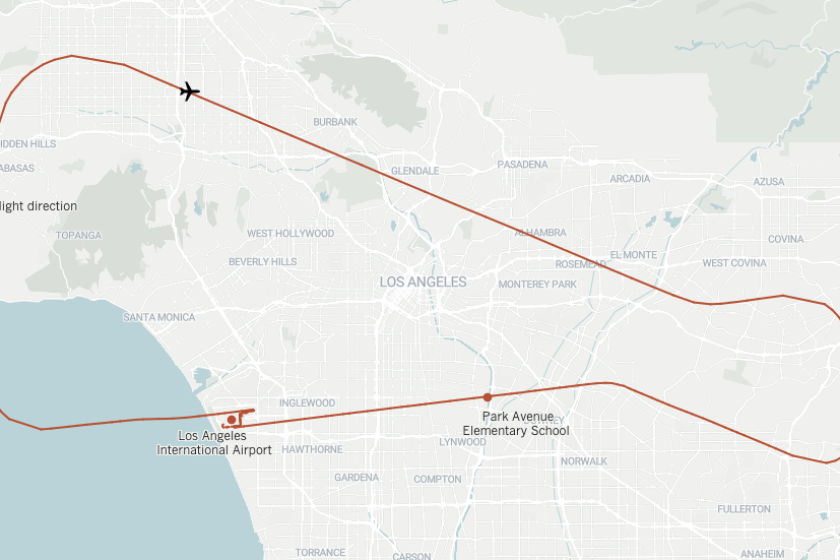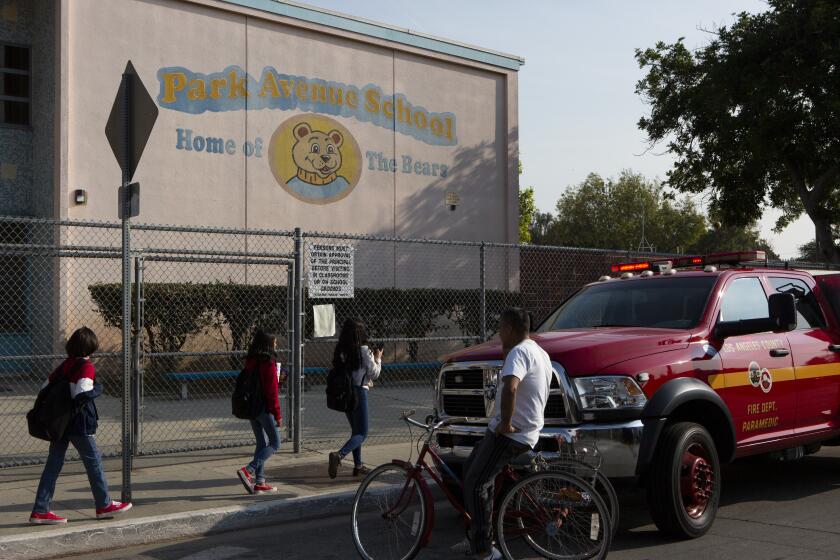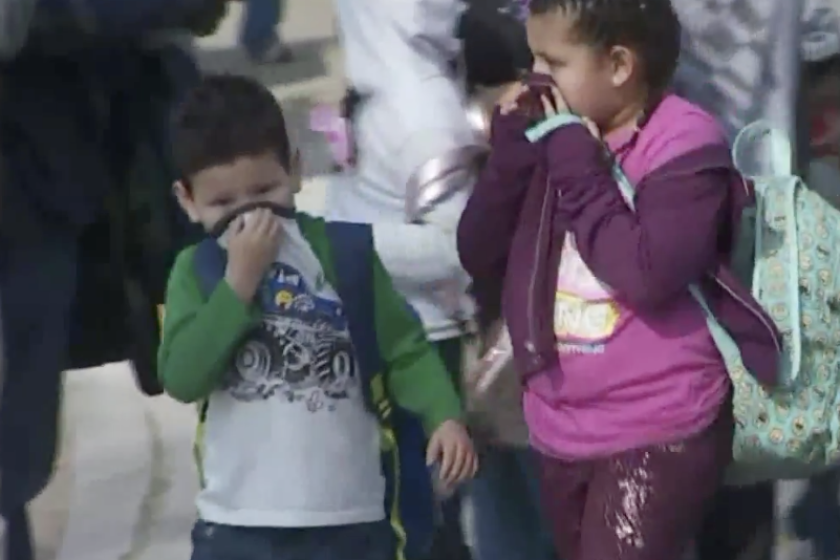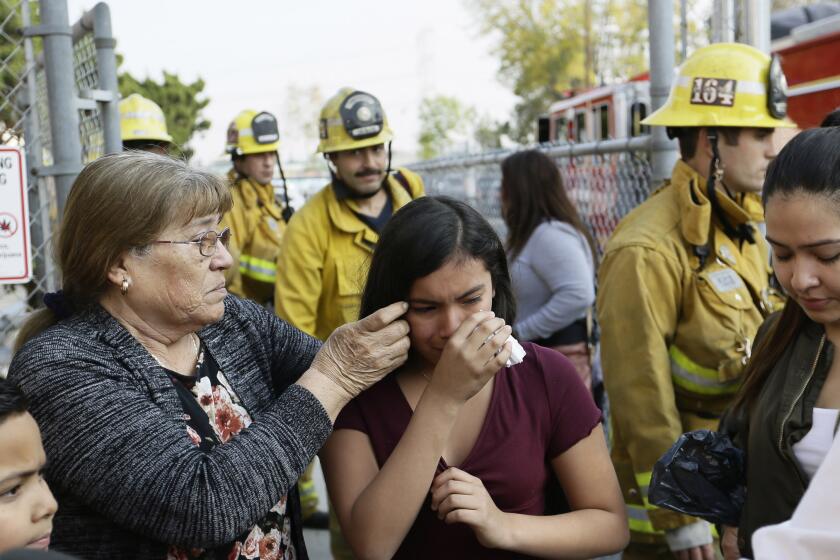Delta jet fuel dump unlikely to cause long-term health problems, experts say

- Share via
It’s been days since a Delta jet experiencing engine trouble showered homes and schools in southeast Los Angeles with fuel, but Aldo Mauricio has continued to have difficulty breathing.
Mauricio lives on Santa Ana Street in Cudahy just a few hundred feet from Park Avenue Elementary, where more than a dozen schoolchildren and teachers were treated after being doused with jet fuel. He says he has suffered from allergies for years, but his lingering breathing issues have made him nervous.
“I would say it’s getting worse,” he said Thursday. He plans to see a doctor if his symptoms don’t improve soon.
Tuesday’s incident has sparked outrage in the area, which has long been at the center of environmental injustices. It’s also prompted concerns from residents who are uncertain about the long-term health and environmental impacts of jet fuel exposure.
In response to public complaints, the South Coast Air Quality Management District sent an inspector to study air quality in the neighborhood this week and on Friday issued a notice of violation to Delta, said Bradley Whitaker, a spokesman for the agency.
The Shanghai-bound flight left LAX, looped over the San Fernando Valley and southeastern L.A. County before making an emergency return to the airport.
Notices of violation can result in civil penalties. In some cases, the company can choose to implement voluntary measures to reduce emissions or otherwise prevent further violations. If no settlement is reached, the agency can pursue a civil lawsuit, Whitaker said.
The Los Angeles County Fire Department’s hazmat team and the L.A. Unified School District also have performed air tests at several locations around the school.
Most commercial planes burn Jet A or Jet A1 fuel, which contain a mixture of hydrocarbons and are kerosene-type products.
“Readings were consistently below the limit of detection for jet fuel chemicals,” Dr. Cyrus Rangan, director of the Los Angeles Department of Public Health’s Toxics Epidemiology Program, wrote in an email. “At this time, odors have also dissipated, which is consistent with the chemical characteristics of kerosene-based jet fuel, in that it is expected to evaporate.”
The Federal Aviation Administration, which is investigating the fuel dump, has argued that vapor pollution from jettisoned fuel is negligible when compared with pollution from cars, trucks and industrial sources. Since it’s a relatively rare occurrence, the agency contends that fuel dumping does not have major environmental implications.
Still, the department of public health, the county fire department, the Environmental Protection Agency and the U.S. Department of Agriculture are continuing to investigate in an effort to better understand the extent of the exposure and its potential impacts, officials said.
The women say they have suffered unnecessary emotional and physical distress.
In the meantime, officials have warned people with vegetable gardens and fruit trees to discard any unharvested produce.
There have been few studies looking at the health effects of short-term exposure to jet fuel, but experts say evidence indicates that symptoms resulting from one-time exposure are temporary. Those symptoms can include skin and eye irritation, headaches, dizziness and respiratory irritation, according to the Health Protection Agency in the United Kingdom.
Rats that were fed kerosene in studies looking at long-term jet fuel exposure showed no increase in tumors. The International Agency for Research on Cancer also concluded that there was inadequate evidence to classify kerosene as a human carcinogen.
Studies looking at jet fuel exposure among military personnel suggest it can affect the nervous system, but that research involved people who worked around the fuel consistently over long periods of time, said Dr. Ulrike Luderer, the director of the Center for Occupational and Environmental Health at UC Irvine.
“Exposure in children really hasn’t been studied,” she said. “It’s such an unusual situation that there wouldn’t be a population to study. Still, we’re likely not going to see significant long-term impacts.”
Three school campuses were affected when fuel was dumped from Delta Flight 89 as it made an emergency landing at Los Angeles International Airport.
Students who were exposed to the fuel vapor Tuesday were sent home with instructions to clean themselves with soap and water and to thoroughly wash the clothing they were wearing at the time. The health department suggested that people discard their clothing if the odor continued to linger after several washes.
Cleaning crews from the airline and school district worked overnight to power-wash the outdoor areas around the affected campuses. While some students returned to school the next day, a few parents kept their children at home for an extra day just to be safe, said Delia Valadez, who has children at Park Avenue Elementary.
Valadez sent both of her boys — ages 7 and 11 — back to school Wednesday, but she second-guessed her decision after teachers sent her oldest son home with severely irritated eyes.
Valadez said she felt safer Thursday than when she rushed to campus to pick up her sons two days earlier. Still, her worries hadn’t completely vanished.
“I’ll be keeping an eye on my boys,” she said.
Radio transmissions between the Delta pilot and air traffic controllers, obtained by The Times this week, have raised further questions about why the pilot dumped fuel over such a large swath of populated neighborhoods.
Federal regulators have said fuel dumping should occur in remote areas. And while the plane was within Federal Aviation Administration guidelines when it dropped the fuel, experts have said the best practice is to discharge at a higher elevation so the liquid dissipates before it hits the ground.
Delta says its pilots were forced to lighten their plane’s load prior to an emergency landing at LAX by dumping fuel over a populated area.
Shortly after the pilot reported trouble with the plane’s right engine — just minutes into the flight bound for Shanghai — an air traffic controller asked him whether he needed to dump any fuel. The pilot responded that he didn’t, but about 20 minutes later, he released fuel over Cudahy and neighboring communities while flying at about 2,300 feet.
Delta representative Adrian Gee said Tuesday the pilot was forced to dump fuel over the urban area to reduce the plane’s weight before its emergency landing.
When a plane is forced to turn back after takeoff, the weight of a full load of fuel carries a risk of damaging the jet, and potentially causing safety issues during landing, said Thomas Anthony, director of USC’s aviation safety and security program and a former FAA investigator.
Even if there isn’t damage, Anthony said, most airlines try to avoid landing overweight because the situation would force them to inspect the plane, which would put it out of service.
“In a case like this, if the plane lands full of gas, you have to apply the brakes quickly and you could bust a tire,” Anthony said. “That creates a potential for fire. It’s a balancing of hazards.”
More to Read
Sign up for Essential California
The most important California stories and recommendations in your inbox every morning.
You may occasionally receive promotional content from the Los Angeles Times.



















